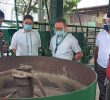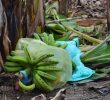By CHERYLL D. FIEL | Davao Today
DAVAO CITY — What happens to a rainforest if you take out its waterfalls? What happens to a mountain if you gouge out its rocks and soil? What happens to indigenous peoples if you take away their lands?
Members of environmental groups posed these questions at a picket in front of the Department of Environment and Natural Resources (DENR) office on Earth Day.
Kerlan Fanagel, secretary general of Pasaka, a confederation of indigenous peoples’ groups in the region, said they staged the protest action to show indignation over the agency’s failure to perform its mandate of protecting the environment.
Fanagel said the DENR has become an agency that leads the destruction of the environment.
He said the government agency has also become an instrument for big businesses to exploit the natural resources in the region for profits, at the expense of residents, particularly the lumads.
.jpg)
Members of the Kadumahan Youth, an environmental group, calls the Department of Environment and Natural Resources (DENR) “an agency leading the destruction of the environment.” They blame the DENR for granting Hedcor’s Environmental Compliance Certificate (ECC) which paved the company’s construction of Hedcor’s hydropower plant in the sacred worship ground of indigenous peoples in Sta. Cruz, Davao del Sur. (davaotoday.com photo by Jonald Mahinay)
Fanagel cited the case of Aboitiz-owned Hydro-Electric Development Corporation (Hedcor) which the DENR allowed to construct hydropower plants in the barangays of Sibulan and Darong, in Sta. Cruz, Davao Del Sur.
DENR approved Hedcor’s Environmental Compliance Certificate (ECC) on March 15, 2006, effectively allowing in early 2007, the start of construction activities for its two hydropower plants, expected to produce an additional capacity of 42.5 megawatts of power in the Davao region.
DENR also allowed Hedcor to tap head waters of Sibulan river and its tributaries for the project, install water pipelines along a network of tunnels throughout a 86-hectare land area and construct a 10-hectare dam above Tudaya elementary school.
But Fanagel said the land where Hedcor is currently building infrastructure for its multi-billion hydroelectric power project is home to the Bagobo Tagabawa tribe of Mt. Apo.
In fact, Fanagel said, the waterfall that Hedcor will primarily use to source electricity to sell throughout the region and throughout Mindanao is a place of worship for the Tagabawa tribe.
The creeks are also the tribe’s sources of drinking water and a natural irrigation for their farms.
.jpg)
captionhead Kerlan Fanagel of PANALIPDAN alliance of environmental organizations explains the destruction that Hedcor will cause to the environment at a protest during Earth Day in front of Department of Environment and Natural Resources regional office in Lanang, Davao City. (davaotoday.com photo by Jonald Mahinay)
Tudaya, being the highest waterfall of Mt. Apo, is the major life support for various animal and plant species that keep the balance of life in one of the few remaining rainforests in the country.
Apo Adoc Puroc, the revered 107-year-old Tagabawa tribe leader said that destroying Tudaya waterfall is also like destroying Mt. Apo since the mist that comes from the fall serves as the natural sprinkler of the mountain’s vegetation.
Environmental group Panalipdan pointed that altering the natural conditions of these important bodies of water would mean loss of biodiversity and eventually, death of the mountain which could mean death for Davao region whose lands are being nourished by its natural topography, the reason for its bounty of fruits all year round.
Panalipdan Southern Mindanao is an alliance of environment advocates, academe, church people, youth, farmers and indigenous peoples groups.
Fr. Medardo Salomia, vice-chairperson of Panalipdan said Mt. Apo’s natural topographic features help maintain climate balance.
Indigenous Peoples









